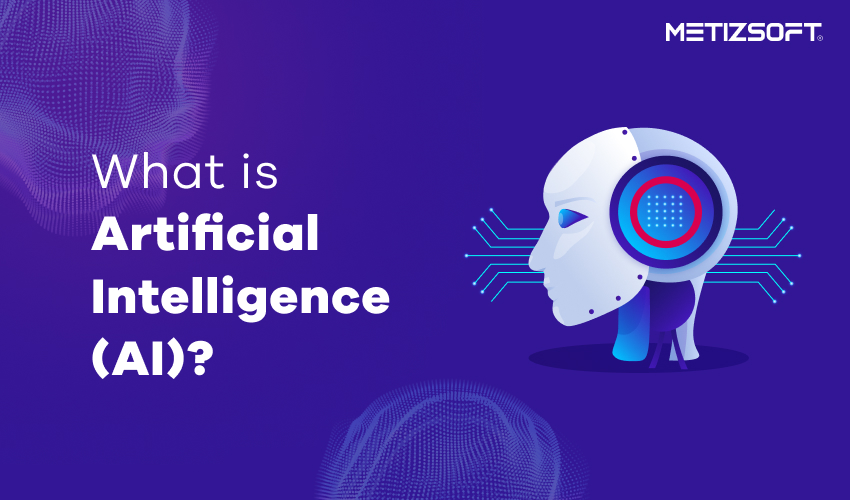
Hey Siri, Alexa, or Google Assistance, please show me the best bakery nearby or help me find the best restaurant near the Eiffel Tower.
In a fast-paced digital landscape, if you understand the above context and how it works, congratulations, you know something about Artificial Intelligence or AI. The above phrase is only an example of AI’s capabilities and how knowingly and unknowingly we use it in our everyday lives. But, in a genuinely technical context, Artificial Intelligence is much more than this.
To decode AI and its types and other aspects, one must thoroughly read this blog, where we have unveiled many prospects of AI, from its meaning to types, cycles, and more.
Table of Contents
What is Artificial Intelligence(AI)?
AI was formally defined in the 1950s as the ability and compatibility of machines to perform tasks that traditionally required human intelligence. Over the years, this definition has been precisely refined with groundbreaking technological advancements and extensive research.
Artificial Intelligence (AI) is an advanced tech field focusing on creating intelligent and agile machines that can learn from experience, solve problems, and naturally interact with humans. AI is used in various areas, such as self-driving cars, virtual assistants, and medical diagnoses by doctors. It involves making machines intelligent and capable of performing tasks that typically require human intelligence.
What are the different types of AI?
Artificial Intelligence systems constitute four main types. They are similar to the weak and robust categories, starting from today’s practical applications and evolving to envision what could exist.
Reactive Machines — Reactive machines are basic AI systems that consistently react to stimuli. They cannot learn and grow, resulting in limited functionality. Deep Blue, IBM’s chess-playing computer, is a prime example of a reactive machine that relied on programmed rules and variables to understand the game of chess.
Limited Memory — Limited memory AI systems can retrieve information and make predictions, but they need human feedback to learn the best way to function. Automated chatbots are an example of this type of AI organizations use to scale customer support.
Theory of Mind — The theory of mind is the first theoretical stage of AI development. It represents when an AI system can detect emotions and use this information to make decisions. This would enable the system to adjust its responses to situations beyond what is possible today.
Self-Awareness — In the distant future, we may create a self-aware AI system that understands humans made it. This system would have human-level consciousness and adaptability, but it would require far more advanced technology than we have now.
Artificial Intelligence’s Working Procedure!
Artificial Intelligence (AI) isn’t about robots with independent thoughts but rather about creating machines that can learn and improve at specific tasks. At its core, AI processes massive amounts of data to identify numerous patterns and then uses them to make predictions or decisions.
To identify spam, you can train Artificial Intelligence (AI) on a labeled email dataset. By recognizing patterns, such as keywords, sender addresses, or phrasing techniques, the AI can accurately predict whether new emails are spam or not.
AI is often created through machine learning, where algorithms improve their performance by analyzing a lot of data and adjusting their internal parameters. This is similar to how a child learns from examples and mistakes.
A facial recognition software’s machine learning algorithm is trained on millions of labeled images to recognize facial features and identify faces in new images. As it processes more data, it becomes better at distinguishing faces and recognizing specific individuals.
Importance of Artificial Intelligence (AI)
AI has become increasingly important in modern society due to its ability to serve various purposes. Here are some key reasons to hope into AI development whenever required:
Automation – AI is quite capable of handling monotonous and time-intensive tasks. This results in heightened efficiency and productivity across diverse sectors, from IT to healthcare and automobile.
Personalization — AI systems offer p by comprehending individual preferences and behavior. Platforms like Netflix, Spotify, and Amazon recommend content or products based on user interactions.
Predictive Analysis & Forecasting — Artificial Intelligence can use past data to predict weather, demand, and stock market trends.
Improves Decision Making — AI systems can quickly and accurately analyze and process vast amounts of data, enabling better healthcare, finance, and logistics decision-making.
Enhances Customer Service – AI-powered Chatbots and virtual assistants can provide 24/7 customer support, answer questions, and solve problems, improving customer satisfaction.
Pros of AI
Let’s review some of the staggering Artificial Intelligence advantages:
Risk Avoidance – AI-powered robots are now replacing humans in dangerous tasks such as coal mining, exploring the depths of the ocean, sewage treatment, and nuclear power plants to prevent disasters.
Reduce Human Errors – Well-programmed machines excel in executing repetitive tasks accurately and efficiently, learning from past experiences, while humans may make errors when handling precision tasks.
Digital Assistance — Digital assistants enable organizations to provide round-the-clock customer service without additional human resources. This delivers faster and more efficient customer service while saving the organization costs.
Automate Repetitive Tasks – In industries, production lines require set sequences of tasks. However, machines have automated many of these tasks, freeing time for humans to be creative.
Cons of AI
No Human-Like Emotion – Machines are faster and more efficient than humans but cannot form emotional connections with people, which is essential for team management.
Higher Cost – Computational devices are upgraded phenomenally, but maintenance is required to keep up with the latest requirements – a resource-intensive task.
Box Thinking – Machines can execute assigned tasks within a defined range of constraints. However, any deviation can lead to ambiguous results.
Top AI Services Available for Use
Consumers and businesses today have access to a vast array of AI-powered services that can help them streamline tasks and simplify their daily lives. You might already have something in your home that utilizes AI technology in some form or another.
Here are some common examples of artificial intelligence services that are available to the public, both for free and paid:
Chatbots – AI-enabled chatbots are virtual assistants that can communicate with people, sometimes human-like, even imitating empathy and concern.
Voice Assistant – Amazon Alexa, Apple’s Siri, and Google Assistant use natural language processing(NLP) to understand and respond to your commands or questions.
Language Translation – Machine learning is widely used in translation services like Google Translate, Microsoft Translator, Amazon Translate, and ChatGPT to translate text.
Image & Video Recognization — Various programs use artificial Intelligence to identify content within images and videos, including faces, text, and objects. Clarifai is an example of a program that leverages machine learning to organize unstructured data from various sources. Another example is Amazon Rekognition, an AWS service that allows users to upload images to obtain information about them.
Software Development — Numerous developers have used ChatGPT to gather information, write code, and debug it for over a year. However, several other AI-powered tools are available that can make a programmer’s job significantly easier.
One example is GitHub Copilot, an AI pair programmer built by OpenAI Codex. It is a generative language model that can assist in writing code faster and with less effort by instantly completing comments and code.
Future of AI: It’s a continuous process!
The future of Artificial Intelligence (AI) is an ongoing journey without a singular destination. AI research is constantly testing the limits of what is possible, with progress being made on multiple fronts. One area of intense focus is Artificial General Intelligence (AGI). AGI aims to create machines with human-level Intelligence capable of learning and adapting to various tasks.
Although AGI (Artificial General Intelligence) is still a theoretical concept, researchers have been making significant advancements in Narrow AI, which are highly specialized systems that excel at specific tasks.
One recent example of Narrow AI is DeepMind’s AlphaFold, an AI system that comprehensively predicts the 3D structure of proteins with unprecedented accuracy. This breakthrough could potentially revolutionize fields such as medicine and materials science by allowing for the design of new drugs, equipment, and materials with specific properties.
The future of AI is a continuous process of development, implementation, and adaptation. With careful planning and ongoing research, AI has the potential to solve humanity’s most pressing challenges and usher in a new era of progress.
Final Takeaway!
As AI technology advances, addressing its ethical and societal implications is crucial. As we incorporate AI more deeply into our lives, it becomes increasingly important to consider bias, transparency, and accountability issues. We must develop and deploy AI systems responsibly to avoid discrimination and unintended consequences.
Furthermore, AI automation will heavily impact the future of work, creating new opportunities in areas requiring collaboration between humans and machines. To handle this transition effectively, we must invest in advanced education and training programs that equip people with the skills to thrive in an AI-powered world. Contact Metizsoft Solutions for more details and custom AI development services!
AboutChetan Sheladiya
Related Posts
How Shopify’s AI Integration is Transforming E-Commerce Personalization
Table of Contents IntroductionThe Importance of Personalization for Shopify StoreShopify Integration with AI: How the Combo...
Build AI-Powered App Using OpenAI API Guide: Benefits, Steps, Cost & More
Table of Contents IntroductionBenefits of Using OpenAI API for Your BusinessSteps Involved in Building AI App Using OpenAI...




